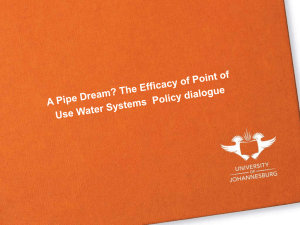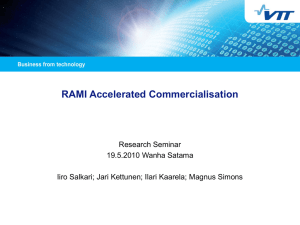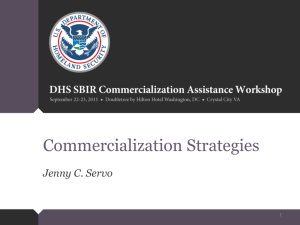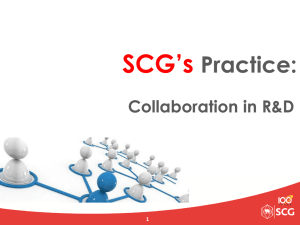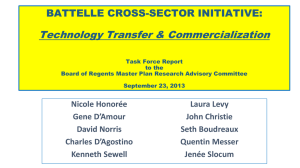110606-bendis - International Economic Forum of the Americas
advertisement
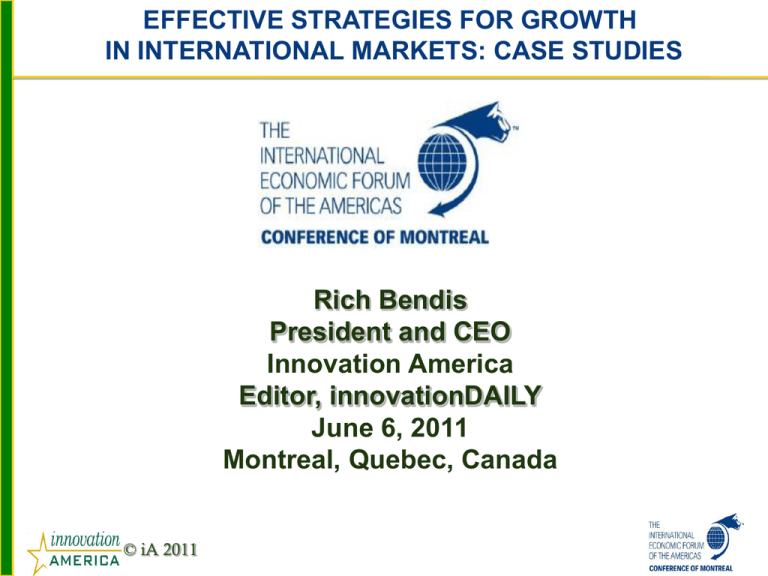
EFFECTIVE STRATEGIES FOR GROWTH IN INTERNATIONAL MARKETS: CASE STUDIES Rich Bendis President and CEO Innovation America Editor, innovationDAILY June 6, 2011 Montreal, Quebec, Canada © iA 2011 The Global Innovation Imperative •Innovation is Key to Growing and Maintaining a Country’s Competitive Position •Collaboration among SME’s and Large Businesses, Universities, and Research Institutes is Essential for Commercialization •New Institutions and Incentives, are important to support collaboration and foster innovation…INNOVATION INTERMEDIARIES •Competition & Economic growth are closely related to education/workforce, human capital, energy, climate change, environmental, natural resource, geopolitical issues & entrepreneurship © iA 2011 2 INNOVATION MATTERS Why Is Innovation Essential? “INNOVATION DISTINGUISHES BETWEEN A LEADER AND A FOLLOWER.” -STEVE JOBS © iA 2011 3 How Leading Nations Responding to the Innovation Imperative? They are providing four things: •High-level Focus •Sustained Support for R&D: Leveraging Public and Private Funds •Support for Innovative SMEs •New Innovation Partnerships to bring new products and services to market Note: Many countries and regions are investing very substantial resources to create, attract and retain industries in leading sectors © iA 2011 4 The New Locational Competition Definition: The competition for economic activity Intense and growing competition among nations and regions for well paid jobs and improving living standards………. © iA 2011 5 Years to Reach 50 Million Users Radio TV 38 years 13 years Internet iPod 4 years 3 years Source: Steve Burrill 60 million status updates happen on Facebook daily © iA 2011 6 The World Has Changed and Is Changing… “Smart phones” (mobile connectivity devices) + Social networks that engage people • Mobile devices like the iPad, iPhone and Android phones – Moved desktop browser activities to mobile devices. – Moved offline activities to online mobile devices. – Made people comfortable accessing sensitive data (e.g. bank accounts) – Social networks – Made people look for answers to their problems – Made people share answers to other people’s problems through their social graph Source: Steve Burrill © iA 2011 7 Global Open Innovation © iA 2011 8 Why Do Nations Need an Innovation Strategy? • Because technological innovation drives long-run economic growth. • Difficulty in addressing complex and systemic challenges. • Markets alone do not produce societally optimal levels of innovation. • Because the stakes have been raised. Source: Rob Atkinson AAAS 2011 © iA 2011 9 What is a National Science and Innovation Strategy? – “Those elements of science, technology, and economic policy that explicitly aim at promoting the development, spread, and efficient use of new products, processes, and services.” – A well-conceived, strategic approach to drive innovation that proactively anticipates and articulates the interactions among policies across: • Tax • Science and technology • Trade • R&D • Intellectual property • Commercialization strategies • Competition/Regulatory • Education & skills • Public procurement • Immigration • Public sector innovation • Statistics/measurement Source: Rob Atkinson AAAS 2011 © iA 2011 10 Selected Nations with National Strategies • • • • • • • • • China Denmark Finland Germany India Ireland Japan Korea Netherlands Source: Rob Atkinson AAAS 2011 © iA 2011 • • • • • • • Norway Portugal South Africa Sweden Taiwan Thailand United Kingdom • Uruguay • United States 11 What is Distinctive About Them? Australia Canada, Denmark Finland Ireland, Japan Netherlands Singapore Korea Sweden All declared a goal to lead the world in transitioning to a digital economy. Source: Rob Atkinson AAAS 2011 © iA 2011 12 Ambitious Goals Lead in Key Technology Areas: IT: Australia, Canada, Denmark, Finland, Ireland, Japan, the Netherlands, Singapore, Korea, & Sweden Clean Energy: Korea, Japan and China Significantly Boost R&D Intensity: Korea, Canada, Turkey, China. Source: Rob Atkinson AAAS 2011 © iA 2011 13 Innovation Tax Policy • Patent box • Collaborative R&D tax credits (Denmark, Korea, France, Japan, Spain, UK) • R&D tax credits to services industries; (Denmark, Netherlands, Norway) Source: Rob Atkinson AAAS 2011 © iA 2011 14 Worldwide Investment in R&D •While U.S. R&D intensity increased by 3% percent from 1987-2008, R&D intensity increased substantially more in most other nations, including: 120% 110% 110% 91% 100% 75% 80% 60% 34% 40% 31% 22% 20% 3% 0% China Israel Korea Ireland Source: Rob Atkinson AAAS 2011 © iA 2011 15 Sweden Canada Japan United States THE BRICs BRAZIL RUSSIA INDIA CHINA Economy growing at an annualized rate of 5% Highest level of educated population among the BRIC countries Poised to become 5th largest consumer economy ($1.5T) by 2025 Rampant capitalism – Public equity markets “hot” Sao Paulo will be the 5TH wealthiest city by 2025 Population set to decline from 143M (2010) to 111M (2050) © iA 2011 16 Importance of Major Research Universities • The primary driver of the future economy and job creation will be innovation, largely driven by science and engineering (Gathering Storm Report) • Global economic competitiveness requires the confluence of scientific discovery that creates knowledge and technological opportunity, workforce talent, and access to enabling resources. • Select contributions of U.S. research institutions to the national economy: –2009: >3,300 patents issued to universities. –More than $40 billion and 270,000 jobs added annually to U.S. economy. –More than 500 companies formed annually around university discoveries. © iA 2011 17 Innovation Economy: Definitions & Terminology • KNOWLEDGE is the confident understanding of a subject, potentially with the ability to use it for a specific purpose • KNOWLEDGE ECONOMY is based on creating, evaluating, and trading knowledge • INNOVATION is the creation and transformation of knowledge into new products, processes, and services that meet market need…….and interactions, entertainment forms, and ways of communicating and collaborating © iA 2011 18 Innovation Ecosystem INPUT “INTERACTION FIELDS” OUTPUT Jobs Networks of Funds Regional Clusters University-Industry Collaborations IP Strategies Wealth Creation Commercialization New Products & Services New Markets Companies The concept of the Innovation Ecosystem stresses that the flow of technology and information among people, enterprises and institutions is key to a vibrant innovation process. © iA 2011 19 Wealth Creation Human Networks Proof of Relevance Basic & Translational Research Proof of Concept Knowledge Creation Education/ Human Resources Private/Public Partnership ACADEMIA INDUSTRY • RESEARCH/T2 • LIFELONG LEARNING • ECONOMIC DEVELOPMENT • PROFIT • PROCESS • PRODUCT INSEPARABLE MISSIONS GOVERNMENT FOUNDATIONS • SUSTAINABILITY • QUALITY OF LIFE • ECONOMIC POLICY • ECONOMIC GROWTH • COMMUNITY INVESTMENT • REGIONAL COLLABORATION © iA 2011 20 Implementing a New Innovation Paradigm • • • • • Deviate from traditional perspectives Encourage public investment and risk taking Develop trust through collaboration Ensuring responsiveness to partners’ missions Build consensus of all constituents through education, participation, and positive outcomes • Move from TBED to IBED • Innovation-Based Economic Development © iA 2011 21 Innovation Paradigm Shift PROOF OF CONCEPT (Technological Feasibility) “It Works!” © iA 2011 PROOF OF RELEVANCE (Market Pull) “It Works To Solve A Problem” 22 Innovation America Commercialization Model © iA 2011 23 Small Business "On average and for all but seven years between 1977 and 2005, existing firms are net job destroyers, losing 1 million jobs net combined per year. By contrast, in their first year, new firms add an average of 3 million jobs," the study reports. – Kauffman Foundation Source: Research Series: Firm Formation and Economic Growth © iA 2011 24 Innovation Capital SME’s Generates 60 to 80% of net new jobs annually Employs 30% of high-tech scientists, engineers, and computer workers Produces 13 to 14 times more patents per employee than large firms © iA 2011 25 Top Reasons Why Start-ups Fail • • • • • • • • • • Management failure Failure to raise sufficient capital Innovation does not meet a commercial need Geography Cultural factors Government laws, bureaucracy, and programs Infighting within the start-up team Problems with IP Poor business plan Unrealistic expectations Source: Beyond the First World – BFW News © iA 2011 26 Government’s Role in Innovation • Long term vision and planning • Identify gaps and trends in science, technology, innovation and SME development • Be a catalyst through long-term strategic investments and partnering • Develop a balanced and flexible research and development investment portfolio • Encourage private sector innovation • Establish performance-based research and development • Accelerate the commercial exploitation of creativity and knowledge, through innovation and research, to create wealth, grow the economy, build successful businesses and improve quality of life © iA 2011 27 Canada and US Cross Border Facts •300,000 travelers cross the Canada US Border Everyday •35,000 trucks cross the border everyday •$1.6 Billion of trade everyday © iA 2011 28 Canadian Based Digital Media Cross Border Collaborations © iA 2011 29 Perceived Government Procurement of Advanced Technology Products - 2009 © iA 2011 30 EU: Pre-Commercial Procurement Pre-commercial procurement is an approach for procuring R&D services which enables public procurers to: •Share the risks and benefits of designing, prototyping and testing new products and services with the suppliers, without involving State aid •Create the optimum conditions for wide commercialization and takeup of R&D results through standardization and/or publication; •Pool the efforts of several procurers. © iA 2011 31 COTEC - Portugal Founded: May 2003 - COTEC is a national innovation intermediary that supports innovative high growth SME’s and is funded by largest private corporations in Portugal Mission: To promote the competitiveness of companies established in Portugal, through the development and the diffusion of a culture and practice of innovation as well as of “resident” knowledge Vision: To become a key agent of business innovation in Portugal, by challenging both public and private organizations of the national innovation system (NIS) and by coordinating its intervention with them Strategic Themes: •To promote a culture of innovation as a crucial source of company competitiveness •To foster the practice of innovation by all the agents of the NIS •To influence the strategic orientation of both the Portuguese and the European Innovation Systems •To remove context barriers to innovation © iA 2011 32 Potential of Global Adaptation of Regional Practices FORMATION OF THE INTERNATIONAL COMMERCIALIZATION ALLIANCE Goals: •Promote international networking and partnerships with a potential outcome of creating new multilateral or bilateral partnerships •Share exemplary practices in the commercialization of outcomes from research in each of our regions •Provide feedback to support these assessments and the metrics •Host annual conference to present and discuss the successful practices, emerging models & determine relevance universally •Share outcomes of commercialization in our regions and the impact of publicly funded research on our customers and stakeholders. © iA 2011 33 University City Science Center Philadelphia Global Soft Landing •Established in 2005 •2 million Sq. Ft. •Wet Labs •Proof of Concept Funding •Focus on Asia and Europe •Relationships with JETRO (Japan), Rhone/Alps Region (France) & Belgium Trade Office (Wallonia Foreign Trade & Investment), Spain, UK and Germany •Networks for Biosciences © iA 2011 34 Jobs! Jobs! Jobs! Does Seed Investing REALLY Create Jobs? © iA 2011 35 Public Investment In Job Creation Category State of PA CDVCA* State of UTAH Funds Invested $90M $26M $60M $291M $800B Jobs Created 8,150 3.700 2,047 28,854 4,000,000 $11,000 $7,100 $29,300 $11,728 $200,000 $ Per Job Invested *Community Development Venture Capital Alliance © iA 2011 36 State of MI Stimulus Bill Innovation Capital Valley of Death “VALLEY OF DEATH” Stage Source POR / Pre-Seed Seed/Start-Up Founders, FFF Bootstrapping Crowdfunding $0K Early Later Angels, IBED, SBIR Venture Funds Accelerator Seed Funds M&A, IPO $500K $2.5M $5.0M Demand “VALLEY OF DEATH” Supply Secondary Funding Gap Funding Gap © iA 2011 37 Funding & Resources for Innovation Capital Seed IBED Federal Angel CRADA PCP © iA 2011 38 Accelerators Traditional & Innovation-Based Development Traditional Innovation (Clusters) Natural resources Highways / Rail Proximity Costs Specialized talent Networks, information University research / professors Market understanding Global Reach i.e. PHYSICAL i.e. KNOWLEDGE • Key values / offerings Business parks Incentives Access to research Workforce competencies Lifestyle • Lead Organization Chambers / EDCs • Competitive Basis © iA 2011 Economic developers Innovation Intermediaries 39 What is a Innovation Intermediary? An Organization at the Center of the region’s, state’s or country’s efforts to align local technologies, assets and resources to work together on advancing Innovation. © iA 2011 40 21st Century Innovation Intermediary Connectivity of Key Human & Institutional Players Cluster Management Research & Marketing of Leverage & Alignment of Funding & Resources Programs Commercialization Direct Investment Angel Capital SBIR Programs Technology Mining / Intellectual Property Programs © iA 2011 41 the Strengths of the Innovation Economy Canadian Innovation Intermediaries © iA 2011 42 European Innovation Intermediaries http://www.innovasjonnorge.no http://www.cotec.pt http://www.vinnova.se http://www.tekes.fi http://techsoutheast.ca/index.php © iA 2011 http://www.senternovem.nl 43 U.S. State Innovation Programs © iA 2011 44 Regional Innovation Clusters Five Key Components to Consider When Defining Unique Regional Assets What you make, including your existing & prospective industry clusters What you do: your workforce skills & human capital base ECONOMIC BASE ENTREPRENEURSHIP TALENT INNOVATION & IDEAS Location, Infrastructure, Amenities, Factor Costs, Natural Resources The basic conditions defining the economic milieu of the region © iA 2011 45 Your capacity to create companies wholly new or from existing firms Your capacity to innovate and generate new ideas Regional IBED Intermediaries © iA 2011 46 What Is A Road Map…..Why Is It Needed? •A roadmap answers the question “Where do we want to be and how to we get there?” •A cluster roadmap provides strategies and action plans to best achieve a vision of the future shared by a critical mass of industry-related organizations. •The strategies and action plans are developed according to the unique strengths of the cluster and region as compared to a global market opportunity. MoCo Vision © iA 2011 47 Innovation America: Innovation Road Map Process 1. Literature Review of Comparables 2. Key Stakeholder Interviews/Recommendations 3. Asset Mapping/Cluster Analysis 4. GIS Innovation Mapping 5. Innovation Benchmarking/Index (Peer 2 Peer) 6. Innovation and Entrepreneurship Resource Identification (Entrepreneur Resource Guide and Database) 7. Innovation Economic Development Organizational Analysis and Matrix 8. Innovation & Commercialization Gap Analysis (programs & services) 9. Innovation Ecosystem Public Policy Recommendations 10. Develop Strategic Plan 11. Organizational Leadership and Staffing 12. Operations/Implementation Plan and Program Portfolio 13. Branding/Marketing Strategy and Market Research 14. Economic Impact Analysis 15. Celebrate Success © iA 2011 48 Bill Gates - Microsoft “Never before in history has innovation offered promise of so much to so many in so short a time.” © iA 2011 49 innovationDAILY www.innovationamerica.us/daily © iA 2011 50 Richard A. Bendis President and CEO Innovation America 2600 Centre Square West 1500 Market Street Philadelphia, PA 19102 (215) 496-8102 rbendis@bendisig.com www.innovationamerica.us www.innovationamerica.us/daily © iA 2011
